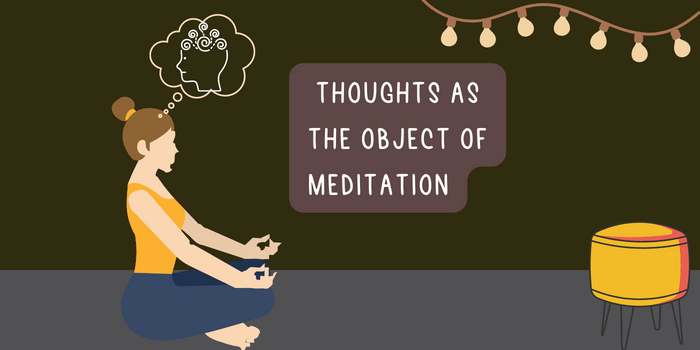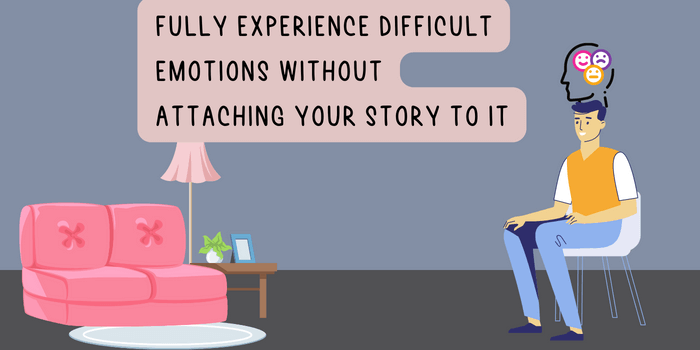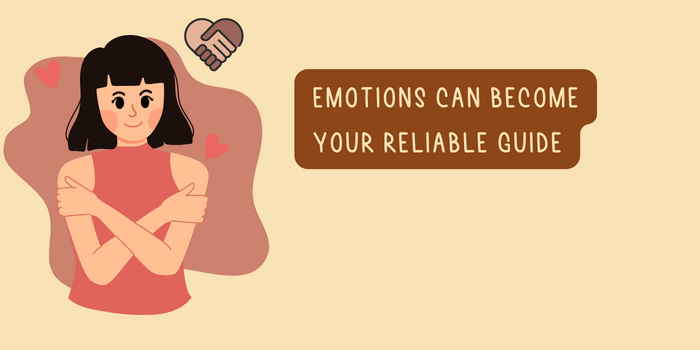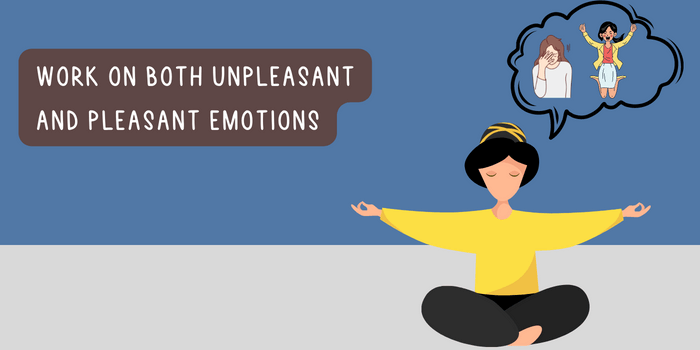Meditation texts recommend that you start with mindfulness of breath for the basic practice.
As you get comfortable with a meditation routine, you can also start using your thoughts themselves as the object of your meditation.
Remember, meditation is not about completely obliterating thoughts and creating a blank mind.
In the previous article we talked about how thinking is the nature of the mind. Thoughts keep arising, whether we are meditating or not. Thoughts come and go, as they always do.
Meditation is the training we undertake to stop engaging with these thoughts. We are simply becoming aware and neutrally observing. We stay in the present by building a deeper awareness of the reality of our experience.
Instead of meditating on the breath, let’s now look at how thoughts can be the object of meditation.
Thoughts as the object of meditation
To begin meditating on thoughts, the initial instructions are the same as before. Settle into a comfortable meditation posture and connect with your breath.
Start by relaxing your body and mind. Focus on the breath for a minute. Allow yourself to get settled.
Now start observing your mind and your thoughts. Are there many thoughts or only a few? Are you thinking continuously or are they broken with spaces in between?
Are you thinking in words or sentences or are they images flashing in the mind? Is it a dialog? Are they nonsensical thoughts?
The intention is simply to place your attention on the thoughts, not to judge or engage with them. Just observe and become aware.
As you observe your thoughts, you will get distracted by some other thought that manages to engage you, and you will have to bring yourself back.
Continue this for some time.
At the end of the session, relax and slowly come out of the meditation.
We often think of thoughts as intruders or something that takes us away from what we are otherwise focusing on.
Such a strong judgment is not needed. As you practise meditating on thoughts, you will gradually become aware of how thoughts always arise, and you can just let them pass through like clouds in the blue sky.

Become A Morning Person Bootcamp
For calm mornings with a daily meditation & journaling routine
Becoming familiar with emotions
Most of our thoughts are pretty light and insubstantial. We do get carried away by them, of course, but not too many of them weigh us down.
As we meditate, we see the thoughts rising, and we are able to bring ourselves back just by mentally noting that we are “thinking” and we can let the thoughts go.
But as you start meditating longer, you will soon come face to face with a different kind of beast – memories and associated emotions.
You will start struggling against your feelings. You will experience a lot of emotions coming up.
So how do you deal with this?
Meditation helps us develop the chops to notice mental phenomena as they arise. The first step, after becoming aware that you’re triggered, is to acknowledge that an emotion has risen in your mind.
One key point I want to add here is that an emotion is just a mental state. Our automatic reactive response to any mental state is to attach our own story to it.
Say it’s your birthday, and you find out that your spouse has forgotten about it. That is an instant trigger for sadness. Lean into this sadness without attaching your story to it. Do not start augmenting the emotion with thoughts about how they’re always forgetful, how they do not care about you etc.
Instead, just fully connect with the sadness with openness, feel its texture.
Where do you feel it in your body?
We will learn to allow that feeling of the emotion become the object of our meditation.
This may seem extremely hard, but it is possible.
We have a lot of aversion to emotions. We seek out ways to push them out of our minds, and numb ourselves with distractions like binge watching Netflix or comfort eating.
We may have built our whole life around activities specifically designed to prevent us from feeling the raw power of emotions. We fear getting caught in its momentum and being swept away, out of control.
Accelerated transformation
Pema Chödrön calls working with emotions “accelerated transformation.”
As you allow yourself to fully experience difficult emotions without attaching a story to it, you’re simply sitting with its raw energy.
This can be painful, yes, but also transformative.
As you get intimate and familiar with the energy of your emotions, you will find that it no longer rules you.
The conditioning does not go away, so it is not that you stop feeling emotions one fine day. But their control over you will weaken, and you will no longer be tossed around helplessly like a rag doll.
Staying with the emotion
Every single person in the world feels strong emotions.
We all know how anger, sadness, or happiness feels. We know how to strengthen our old patterns of anger, so we end up getting angrier and angrier, seething at the world and ourselves. We know how to sink into self-pity and resentment.
To stay with the emotion without getting rattled, we must learn to accept it just as it is.
Each emotion is unique. It doesn’t have to be good or bad. It is just what it is, there is no need to qualify or augment or reject it.
Experience the emotions fully, just as they are. It is difficult, but the result is that you stop struggling and the emotions don’t escalate further.
It is when you get caught in the momentum and spin off that you start the whole chain of suffering.
An emotion that we choose to exaggerate is like a stone that is dropped heavily into still water. The ripples of suffering start instantly.
In meditation, we train ourselves to stay with the emotion rather than get caught up in automatic reactivity. We learn how to gently drop the stone without causing the ripples.
When you do not fear or reject your emotions, and instead lean into them, they become your friends that can guide you.
Your emotions as the object of meditation
When you start training with emotions as the object of meditation, start with a lightweight emotion – something that does not have any trauma attached to it.
Something unpleasant like the irritation you felt when a colleague talked over you at work could be a good starting point.
As you get comfortable handling such mild irritations, you can work your way up to difficult emotions.
Now let’s get into the technique.
Sit for meditation and find an unpleasant memory to work with. Like the one where your colleague talked over you.
Now, find a pleasant emotion as well. Perhaps someone praised you for a job well done. Think about how good you felt.
These are the two emotions that we will work with.
Start your meditation by focusing on the breath for about 5 minutes. Bring your focus back when the mind wanders. Settle into it.
Now, recall the unpleasant emotion and place it in your mind. Lean into it and pay full attention to it. What is the texture of that emotion? How would you describe what it makes you feel? Where in your body do you sense this emotion? Get in touch with the energy it creates in your mind and body.
As you pay attention to the emotion, your mind will wander off into the story that you attach to the emotion. When you become aware of the mind wandering, gently bring it back without judgment or frustration.
As the thoughts arise, notice them and notice the thinking, then sink back into the experience of the emotion.
Do this for a while, and then rest in open awareness, where you are attentive and observant, but not focusing on anything specific.
This training allows the heart to open and compassion to arise. You become familiar with compassion for yourself and for others.
Repeat the same exercise, now bringing to mind the pleasant emotion.
This practice is how we uncover the true nature of our minds. You connect to the natural openness of your mind, and move away from the habitual pattern of fixating and telling stories. We learn how to do this in a compassionate, friendly way.
This is how we grow.




